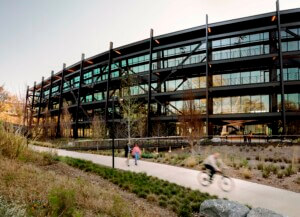AN has partnered with El Paso, Texas–based AGENCY to bring readers Border Dispatches, “an on-the-ground perspective from the United States-Mexico border.” Each month, the series explores a critical site or person shaping the mutable binational territory between the two neighboring countries.
While architects commonly use mock-ups of custom elements, construction details, and assemblies to gain confidence over the future prospects of experimental endeavors, the national security complex amplifies this logic at a much larger scale: building entire mock infrastructures and city-scale installations to test and refine its operations, procedures, and footprint.
Among the many replicas of critical infrastructure populating a growing number of law enforcement training sites in the United States, the port of entry (POE) is an increasingly common typology, used for training U.S. Customs and Border Protection (CBP) agents and related forces in the duties of facilitating and managing the various flows of people, vehicles, and goods which enter and leave the country.
In the annals of security training, the port is an archetypal and enduring site, a frontline where the oft-competing interests of international commerce and national security collide. Since the establishment of the U.S. Customs Service School of Instruction at the Port of New York in 1935, ports have been a fertile testing ground for young customs officers and border agents to learn their crafts in situ, embedded amid the swirling complexities of life at the edge of sovereign territory. Interstate boundaries belie similar dynamics, with port-of-entry training a common feature of state patrol academies as well.
Over the years, security officials have conducted tests to improve efficiency at mock ports of entry. In a multinational security experiment hosted by the U.S. Department of Homeland Security (DHS) in 2004, participants from 18 countries worked through a debugging session for the use of e-Passports, document readers, and facial recognition devices in a makeshift simulated port in Morgantown, West Virginia. Fitting the artificially smooth, fictionalized setting, each participant held simulated travel documents from the nation of “Utopia.”

Recently, this pre-collection and efficiency strategy has broadened its scope at operational ports to include the capture of Bluetooth wireless signals from travelers’ portable electronics, which the CBP gathers in order to—per official statements— issue wait-time updates to would-be travelers. The recent Laredo POE Mobile Query Pilot program distributed clearance operations to arriving busloads of simulated travelers, using “smartphones paired with a peripheral to perform document reading and biometrics capture.” With current projections focusing on further streamlining operations and securing territory “between ports of entry,” this extension of port security space continues to spread.
Meanwhile, the security objectives of the port site itself have diversified and intensified, with a growing host of initiatives and technologies coming together under one roof. In the first week of September 2001, reflecting a growing dissatisfaction with what was seen as a fragmented operational environment at the nation’s ports, the U.S. Congress began requesting funding to build a port of entry training facility at the Federal Law Enforcement Training Center (FLETC) site in Glynco, Georgia. In the following week, the attacks of 9/11 put all of the nation’s ports of entry at an elevated Level 1 alert. Shortly after, border security efforts were consolidated under the newly formed CBP. Officers at ports would be assigned new, broader security roles. The ports and their simulations would need to adapt.
FLETC partnered with CBP to construct the mock port, integrating new security directives while building on a history of port simulation on site. As early as 1998, the Immigration and Naturalization Service was using mock stiles at the FLETC site to test systems for tracking foreign-visitor travel through ports of entry. Construction was completed in 2003. The 22,600-square-foot facility boasted “state-of-the-art computer systems” and “primary and secondary inspection points for pedestrian and vehicular traffic,” complete with license plate readers and radiation monitors to acquaint trainees with the layered logistics of port screenings. Since beginning operations, trainees have used the simulated environment for a wide range of practical exercises, conducting mock vehicle searches, training canine units for human detection, and simulating treasury enforcement operations with the use of role players and computer tracking. In 2007, it was common practice for trainees to enter the FLETC port simulation environment after initial training at their assigned real-world POE. In a kind of mirrored urbanism, their environmental awareness would be augmented and accelerated at the mock port, seen as a kind of interchangeable extension of and stand-in for any of the over 300 real-world sites, only for the trainees to return to their home posts for duty.
The mock port has been somewhat of a calling card for FLETC and a focus around which other simulated developments continue to aggregate at the center. A 200-acre counterterrorism training environment including “rural and urban neighborhoods, buildings, and roadways” sprawls nearby. A former dormitory was converted to resemble a federal building for training. An intermodal site was built in the complex, where students train for emergencies interfacing with other forms of vulnerable infrastructure; buses, trains, aircraft, and subway systems dot the site. With an increase in demand for CBP port agents, a planning proposal in 2015 included increased training capacity at the mock port site, expanding “simulation areas and laboratory and practical exercise areas” for trainees.

While the FLETC port site specializes in the required training for CBP port agents and other federal agencies, other simulated port environments expand the breadth of security training offerings, along with the types of sites and constituencies they engage. The HAMMER Federal Training Center in Richland, Washington, reportedly designed by the U.S. State Department, hosts a 1,000-square-foot mock port of entry, decked out with a “vehicle inspection pad, radiation portal monitors, and sealand cargo containers.” Training exercises here focus on law enforcement searches of containers for possible threats or smuggled material. Pacific Northwest National Laboratory uses “a series of mock port-of-entry configurations” to conduct mock-inspection exercises, anticipating and resolving emerging threats. PNNL works in concert with the Domestic Nuclear Detection Office to conduct studies in how to improve radiation-detection technologies and procedures to eliminate false positives and improve detection response.
At times, it seems, the simulated environment cannot match the fidelity of its real-world counterpart, and training takes over operational port sites. Multiple agencies recently converged at the Ysleta POE, in El Paso, Texas, for hazardous material (HAZMAT) training simulation. Trainees responded to a mock battery-acid contamination scenario, in which three role-playing victims were affected by defective forklift batteries in transit on an 18-wheeler. CBP partnered with the DHS’s Office of Science and Technology to construct a mock air POE to test prototypes for biometric exiting strategies at airports in 2014. The experiments were later conducted in real-world airports. The Nogales Port of Entry has hosted a number of mock disasters and counterterrorism drills, including at least one role-playing suicide bomber.
Since 2014, the CBP has been authorized to partner with private-sector interests to construct and improve POEs. The federal agency is allowed now to accept donated real estate to construct or expand its operations at ports, in a bid to expedite the retooling of this critical security infrastructure. The architectural and operational experiments conducted in the nation’s parallel network of simulated port urbanisms prevision this next generation of border stations. We imagine these new sites will be a different kind of test-bed—where real estate speculation and commercialization of the port as commodity will create a new layer of managerial complexity at our nation’s borders.











